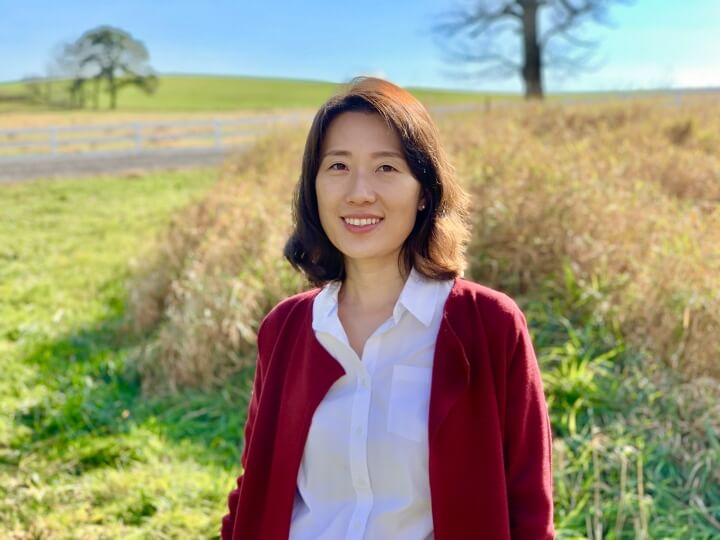SeungYeon Kang, Ph.D. ’14
As an engineer working for Samsung, SeungYeon Kang, Ph.D. ’14, recognized a gap between theory and realization in the products industries were designing.
“Even though people had big ideas about what to make or how to make it, there was often a lack of technology or method to do the actual fabrication,” Kang said.
As an Assistant Professor of Mechanical Engineering at the University of Connecticut, Kang’s goal is to bridge that gap. Her lab studies how light and matter interact, researching the use of ultrafast femtosecond lasers to 3D-print complex objects such as optical devices, metamaterials and sensors. Her team also plans to use lasers to study how light and matter interact in energy storage systems.
“Our research is very interdisciplinary,” Kang said. “You need knowledge not just in mechanical engineering but also in materials science, chemistry and physics. Our work in 3D printing requires analysis on mechanical, optical, electrical, and thermal performances. Lithium Ion battery is another area that we are focusing on, where cell deformation changes electrochemical performance. So, all of that plays together.”
When it comes to lasers, Kang couldn’t have asked for a better advisor than Eric Mazur, Balkanski Professor of Physics and Applied Physics at the Harvard John A. Paulson School of Engineering and Applied Sciences (SEAS). A leading researcher in the field, Mazur has been studying the applications of femtosecond lasers for decades. Mazur’s research and the Harvard Center for Nanoscale Systems drew the interest of Kang when she was a chemical engineering major focused on nanotechnology at Cornell University.
“As a child, I was always interested in making and playing with small structures,” Kang said. “When I was an undergrad at Cornell, the field of nanofabrication and nanotechnology got big, so I got interested in making things that are very small, complex and high-tech.”
Kang joined Mazur’s group in 2008 as a Ph.D. candidate in applied physics. Their research into direct laser writing became the basis of the additive manufacturing research on which she’s focusing at UConn.
“I liked the interdisciplinary department Harvard had,” Kang said. “All the research areas were very connected, and there wasn’t a clear distinction between the different engineering disciplines.”
A native of South Korea, Kang returned home to develop lithium-ion batteries at Samsung after finishing at Harvard. She spent three years in this industry before becoming a postdoctoral researcher at Princeton in 2017, and has been in academia ever since.
“After this industry experience, I realized that I really like the academic setting, where I have more freedom and flexibility to do research on things I’m curious about,” Kang said. “Samsung is great, but it’s a large manufacturing company with short deadlines. You have to basically come up with a new phone product every six months or a year, for example, and for me I wanted to take a step back and think about how and why things work.”
Kang now gets to do all of that at UConn. She started as the program site manager for the Center for Science of Heterogeneous Additive Printing of 3D Materials (SHAP3D), an industry/university cooperative research center funded through the National Science Foundation.
“I wanted to stay in 3D printing, additive manufacturing and fabrication, and the SHAP3D Center was the perfect way to connect all of that,” she said. “I’d also get to interact more with industry members to broaden my knowledge and potentially set up future funding opportunities.”
In 2020, she joined the UConn mechanical engineering department as a research professor and became an assistant professor at the beginning of 2021. She currently teaches about 75 students in her course on thermodynamics and is looking to develop a new course on additive manufacturing.
“I like the multidisciplinary aspects of academia, and I like teaching, interacting and affecting the lives of students in positive ways,” she said.
Studying with Mazur didn’t just teach Kang about lasers and 3D printing. Academic advisors like him inspired Kang’s entire approach to research and teaching, where the lines between academic fields are always fluid, and one should always be looking for new applications and approaches to the research. As her own career in academia blossoms, Kang now looks to inspire that same attitude in her students.
“I was very lucky to have great advisors,” Kang said. “They were all very open-minded, and none of them had micromanaging advising styles. They liked interdisciplinary research, and always encouraged me to work on whatever I was curious about.”
Press Contact
Matt Goisman | mgoisman@g.harvard.edu
